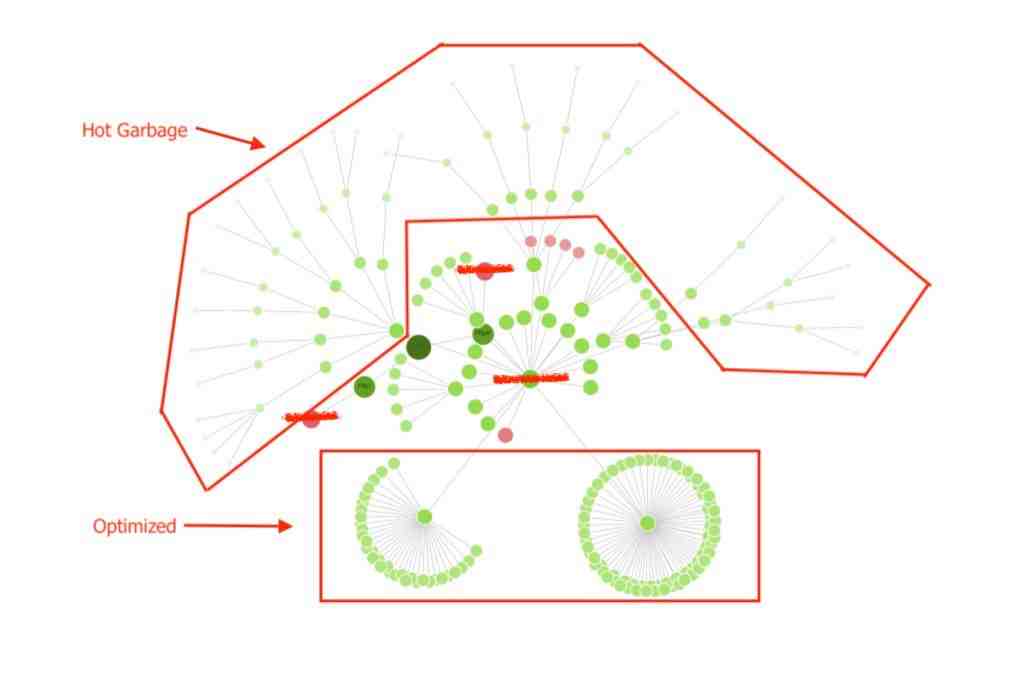For those who have been in SEO for a while, you might have heard of site taxonomy as it refers to the website.
When you refer to the structure of a website and how easy it is for users to navigate, you are referring to the taxonomy of the site.
Paying attention to your site’s taxonomy is an essential skill that SEO professionals need to master.
Indeed, a site’s taxonomy influences not only its overall organizational structure, but also how it is perceived on Google and how users navigate your site.
For this reason, putting optimizing your site’s taxonomy in your queue (hopefully in a high priority position) is a critical step towards a solid website architecture.
What, Exactly, Is A Site’s Taxonomy?

When we talk about taxonomy, we usually refer to a classification system.
This classification system will control everything in a site’s structure, from organization to classification – and it’s all based on their semantic characteristics and how they relate to each other.
Your website’s taxonomy is something that can play an important role in how Google crawls your site, as well as how your users will perceive their user experience.
It can also have a big impact on search engine rankings. It pays to focus on your website taxonomy, how it looks on your site, and how it is set up as a whole.
Your website’s taxonomy can also play a role in how your site builds internal links, which can also be a significant boost to your website’s success on Google.
Google Guidelines: Create A Clear Conceptual Page Hierarchy

If you were wondering whether or not this was a black hat tactic, it’s not.
It’s actually a white hat technique.
Because you focus on your content organization, you are safe from being interpreted by Google.
In fact, Google’s webmaster guidelines state that you should create a hierarchical taxonomy:
Design your site to have a clear conceptual page hierarchy.
Google prefers a clear conceptual taxonomy structure that includes top-level categories based on the type of content on a site.
This structure should also include related topics organized within it.
The Different Types Of Taxonomies

There are several types of taxonomies that can help you create your taxonomic structure. They include flat taxonomies and faceted taxonomies.
Flat Taxonomies
Flat taxonomies, or hierarchical taxonomies, are easily used when you have a group of topics where the semantic relationship is already very well known.
Entities are easily used in a flat taxonomy with a classification dimension.
Using a parent-child relationship for these entities can help Google dig deeper into a topic and can help organize things in a logical way for users.
Faceted Taxonomies
You can use faceted taxonomies when you have a topic with many different classification dimensions (as opposed to just one).
It is possible to use faceted taxonomies to organize a comprehensive and in-depth library.
Whether you organize all the different types of dishes in your kitchen or organize thousands of products with similar and different classification dimensions, you may want to use faceted taxonomies.
The interesting thing about faceted taxonomies is that full knowledge of the semantic relationship between entities is not required.
It is possible to construct an ad hoc taxonomy that encompasses all of these content items, regardless of their location in the taxonomic spectrum.
Okay, I’m Sold On A Site’s Taxonomy. Why Is This So Important?

Creating a well-organized taxonomy can really impact how users interact positively with your site. This is especially true when you have a logical organization of your content.
The better a site’s taxonomy, the more trusted source your users will see you, and the more they’ll stick around and read your stuff.
If a site does not have a specified structure, it will be very difficult for users to understand and consume your content.
Many users will leave a site if it is poorly organized. We want to make sure users spend as much time as possible when trying to navigate your website.
It is also essential for SEO, as it allows Google to better understand the architecture of your site. Plus, it makes crawling and indexing easier for bots.
Creating the appropriate relationships between semantic definitions that apply to Google’s knowledge graph also explains how Google will understand your site.
The easier it is for Google to analyze and understand your site’s overall taxonomy, the better your site will perform in search engines and for your users.
Let’s take a closer look at this with a sample search engine optimization website (maybe you own ilovedoingseonallthethingsintheworldsosueme.com).
Suppose your site targets a variety of topics in the field of search engine optimization. They can include things like:
These are all categories that you can use to organize your content.
If one of your users is looking for topics on SEO, content writing, or content marketing, the taxonomy might look like this:
The first part of the URL (/content-writing/) is the category.
And if someone is looking for something like content writing, they will probably go to this category page, where they can find all the articles on the topic that are organized under that category.
It is important that closely related topics are organized in this hierarchical navigation.
Site Taxonomy: Best Practices For Creating The Navigational Hierarchy

The absolute first guideline here is to make sure your site’s taxonomy is good for users and search engines.
You want to strike a balance between ease of use and ease of navigation.
If users can’t navigate the site and find the content curated, you can’t grow your site further.
That’s why we separate this type of content into these categories: to better organize and present it to users and bots.
The easy dual-navigation is a win, both from an engineering perspective and a human factors perspective.
Make Sure You Do The Relevant Keyword And Topic Research
A solid foundation for any successful SEO strategy is doing the right keyword research and researching your topics. One cannot exist without the other.
Keyword research is necessary to learn more about what your audience is looking for online.
Topic research is necessary to learn more about the interests of your audience.
The combination will help you organize your taxonomy into useful categories and content written within those categories.
By doing things this way, you don’t miss a thing and hit any pain points your audience might encounter elsewhere – providing a much higher quality experience than otherwise.
All of those keywords you search for should be related to any content you might produce that will appear on those pages.
You will choose a subject for the taxonomic category. Next, you’ll choose topics and keywords to group under.
This will help you create a group of relevant topics that will strengthen your focus on certain topics on your site.
However, it’s important to note that you don’t have to optimize things as much as you used to.
You don’t have to include your target keyword in every paragraph, sentence, or whatever. Instead, you want to make sure your content is organized and structured around the topic, and that you write naturally.
Google’s algorithm will help make extrapolations about the meaning and understanding of your content as a result of crawling it.
But, you still want to include keywords. And you always want to optimize based on what software like Frase is telling you.
You just don’t want to use keywords.
It’s also useful to read up on entities once you’ve entered the keywords. When you create your site’s taxonomy, it will help inform your thematic entity map.
Keep Your Site Taxonomy Simple
Building a taxonomy with hundreds of categories and subcategories is an exercise in futility. You are only making things worse for your site in the search engines and making things harder for Google and your users.
The worse your site structure is, the harder it is for Google to crawl and index – and the longer it takes. It can take your users eons to find what they are looking for.
While it’s possible to come up with such a taxonomy structure regardless of your niche, the reality is that it just adds friction between what your users want and what Google wants to see.
The more friction you add, the harder it becomes for users and search engines. An ideal site taxonomy is easily navigable, topic-focused, and simple enough for users.
Keeping your taxonomy simple also means making sure you have fewer main categories and where those categories may have other subcategories.
It is possible to have a top-level category focused entirely on on-page SEO, and the content you post in this section will only be about on-page SEO.
You can set up your taxonomy structure in different ways.
You can have a pure category structure that focuses only on organizing the pages within that category, or you can have a more granular detailed structure to organize your topics into a true physical silo.
The possibilities can be endless, but the results tend to show that simpler taxonomies are preferred over the more complex problems that hundreds of taxonomies can bring.
Don’t Forget About Your Audience When Creating Your Taxonomy
This should be common sense, but more often than not, it’s not that common.
To create the most effective site taxonomy, it’s important to know exactly who your audience is and why they are on your site.
You also need to know their needs and how they generally search. Also, you might want to understand how they use websites in general.
This way you can properly structure your content into the appropriate taxonomy.
Buyer personas are a great tool you can use to identify these facts.
For example, if your audience is looking for SEO, it helps to know what they expect from that navigation.
You can find out by looking at websites that are already optimized in your niche, or you can use a site like usertesting.com to get real users to browse your site and provide feedback on it.
Along with figuring out how to present information on their main topic, you also want to know what supporting topics they might want to know about and include them in your navigation.
Continuing with “example.com”, for example, is there anything that can help improve the subject?
By spending time digging into your users, you can ensure that your overall site is designed accordingly and can better serve their needs.
You Also Want To Leave Enough Room For Growing Your Site
If you only have a finite number of categories and only deal with those topics, you will eventually run out of discussion topics.
That’s why it’s essential to make sure you leave enough room for your site’s taxonomy to grow.
It’s not just about making sure you have enough to talk about, although that’s a big part of it.
Your taxonomy is likely to change as your business grows.
As new types of content are created, you will likely need to move some categories around to ensure everything is still interrelated.
You also need to make sure you have room for new content items.
For example, suppose you have an existing taxonomy that covers some blog topics.
You hire new team members. They are all well versed in related topics in this regard.
But you don’t have them in your taxonomy. As you grow your team of subject matter experts, you will also need to expand your categories across your entire blog.
It’s also possible that you change your mind and find that some categories aren’t as strong as you initially thought.
That’s why it’s so important to be open to change and adapt to your changing circumstances.
You don’t want to be so rigid that you’re not open to your audience’s possibilities for change (and they will).
On the other hand, you also don’t want to constantly change your site’s taxonomy because you’ll lose stability in search results.
It’s critical to find that balance that works for your users and the growth of your business.
Consistency Is Always Core To A Successful Strategy
As you get better at creating taxonomies, you will refine your own consistency, which is a very important factor for SEO.
If your site is poorly organized or contains irrelevant content, it may be considered not of very high quality.
Google is smart enough to understand the semantic relationship between your content, and you need to make sure your navigation hierarchy is organized enough to facilitate these taxonomic semantic relationships.
By making sure you create a consistent and structured taxonomic hierarchy, you create a simple and easy website structure that Google (and your users) can follow.
It makes it much easier to find content and allows you to organize your content items within this taxonomic structure.
This hierarchical structure is also search engine friendly, with lots of “spider food” to feed Google, so it understands exactly what your whole site contains.
A well-planned taxonomy is also inherently consistent because it lends itself to more consistent thematic navigation and allows you to easily present your content to readers.
A navigation menu organized into a well-planned taxonomy makes it much easier to ensure a consistent, high-quality content search factor.
Your URL Taxonomy Can Significantly Impact Your Site’s Architecture
Making your site easier to navigate for search engine crawlers and your users is the ultimate goal (or should be) of any enterprising SEO professional.
Your URL taxonomy can be the difference between your site’s success and failure.
By creating a hierarchical taxonomy that includes the full semantic relationship between your topic entities, it’s possible to continue feeding Google the right signals while ensuring your site isn’t too difficult to understand.
Let’s look at the following taxonomy examples to further clarify our taxonomic preferences:
Examples Of Bad URL Taxonomy
Like most SEO practices, there are good URL taxonomies and bad URL taxonomies. Terrifyingly bad (worst of the bad) URL taxonomies include the following:
The problem with these URL taxonomies is that they are very complex and could lead to some devaluation of your site, as Google cannot care to understand the complexity of these URLs.
That’s why it’s best to always use a simple taxonomy, whenever possible, and not get too complex.
Also, these types of taxonomies do not group everything properly, nor do they group your blog posts under one website section.
Also, they don’t have relevant content based on the URLs that are displayed in that particular taxonomy.
Examples Of Good URL Taxonomy
A good URL taxonomy, however, creates a structure that is easy to understand, easy to explore, and easy for users to read. For instance:
Good URL taxonomies (like the ones above) are best because they help – again – make your content easier to find.
They also help users because if they see your URL in Google search results, it’s shorter and more memorable.
They help spiders because they use less processing power.
Ensuring you stay consistent with a good URL taxonomy caters to both users and search engines.
Creating The Relationship Of Your Content Within The Silo
When you focus on relating your content within a silo, you want to group all of your related pages into an organized silo.
This helps build a better taxonomy foundation for your site.
Organizing your content by taxonomy allows for easier content discovery, especially if it’s organized into the proper silo.
When you organize your content based on the relationship of that content within that silo, you provide Google with a better understanding of your content.
Google will then determine that all of your content grouped in this silo must be linked in some way.
Using this hierarchical structure to organize your content pages into a silo also provides greater content discoverability.
Create Internal Links Across Content Silos
Remember to build internal links across your content silos.
Internal linking is a powerful tool that can help you think through website taxonomy.
Creating internal links between different content silos helps Google better understand the relationship between different types of content.
Ideally, you want to use links with the appropriate contextual content surrounding them so that you can provide the essential contextual relevance of that link.
This practice will help both users and search engines when it comes to helping them learn more about the relationships between topics on your site.
Make Your Site Future-Proof With The Right Taxonomies
Creating the right site taxonomies is something that will help future-proof your site.
Not only will this help with topical relevance and timeliness, but it will also help ensure that search engines discover your content in the correct way that you want.
Also, it helps build topical authority.
Since your site is organized this way, you also build topic authority through the links and contextually relevant URLs you create.
Making sure you create the right taxonomies builds your site’s authority on the subject.
You also create an organized, hierarchical taxonomic structure that Google loves and provide a contextual home for all of your content.
What do you plan to do with your next site’s taxonomy implementation?
Featured Image: BestForBest/Shutterstock
What are the three components of taxonomy?
Taxonomy is the field of scientific study dealing with the identification, naming, and categorization of entities based on common traits in an appropriate manner. The 4 basic components of taxonomy are characterization, identification, naming and classification.
What are the three purposes of taxonomy? The purpose of taxonomy is to categorize organisms based on their common characteristics and descent. The main purpose of taxonomy is to identify, characterize, classify and give specific names to all living organisms according to their characteristics.
What are the steps of taxonomy?
Note: taxonomy includes: identification > characterization > classification > nomenclature. This system classifies a living organism according to the order mentioned above.
How many types of taxonomies are there?
There are seven main taxonomic ranks: kingdom, phylum or division, class, order, family, genus, species.
What are the three types of taxonomy?
Three types of classification systems are artificial system, natural system and phylogenetic system.
What are the 7 taxonomies?
Classification, or taxonomy, is a system for categorizing living things. There are seven divisions in the system: (1) Kingdom; (2) phylum or division; (3) Class; (4) Command; (5) Family; (6) Gender; (7) Cash. The kingdom is the largest division.
What are the 8 categories of taxonomy?
The modern taxonomic classification system has eight main levels (from most inclusive to most exclusive): Domain, Kingdom, Phylum, Class, Order, Family, Genus, Species ID.
What does taxonomy include?
Taxonomy is the science of naming, describing and classifying organisms and includes all plants, animals and microorganisms in the world.
What are the four types of taxonomy?
Overview of the Phylum taxonomic hierarchy – a group of related classes. Class â a group of related commands. Order â a group of related families. Family – a group of related genera.
What are the main features of taxonomy?
The main purpose of taxonomy is to identify, characterize, classify and give specific names to all living organisms according to their characteristics. Plants and animals are classified into different taxa, e.g. kingdom, phylum, class, order, family, genus and species.
What is basic taxonomy?
The word taxonomy is the term used to describe the classification of living things. The taxonomy of living things starts at the broadest level and moves to the most specific level. The basic taxonomy of living things includes eight distinct levels. Each level of taxonomy is called an individual taxon.
What is SEO taxonomy?
What is a taxonomy? A taxonomy in SEO parlance is a group of URLs with a common attribute that therefore share relevance with each other. A URL taxonomy does not need to follow a specific URL structure, nor be in the same architectural depth from the home page.
What is the keyword taxonomy? The taxonomy consists of a total of 59 keywords spread over three levels of the hierarchy. The taxonomy is presented in Figure 1 and shows the variability of topics in data quality research, ranging from highly technical issues such as similarity joins for data linkage to very general issues such as data reliability. .
What is taxonomies in Yoast SEO?
When creating or editing a post or page, you can assign categories and tags to it. These categories and tags are your taxonomies. And each taxonomy has a page where people can find an overview of all posts and pages with that tag or in that category.
What are taxonomies in WordPress?
A WordPress taxonomy is a way to organize groups of posts and custom post types. The word taxonomy comes from the method of biological classification called Linnean taxonomy. By default, WordPress comes with two taxonomies called categories and tags. You can use them to organize your blog posts.
What is SEO taxonomy?
A taxonomy in SEO parlance is a group of URLs with a common attribute that therefore share relevance with each other. A URL taxonomy does not need to follow a specific URL structure, nor be in the same architectural depth from the home page.
What is tag taxonomy?
Tagging taxonomies establish agreement on how to collect, interpret, and act on research. They create a shared understanding of an organization’s domain, products, and services. Taxonomies communicate an opinion about what is important and inspire the exchange of ideas within the organization.
What is the difference between tags and taxonomy?
Tags are similar to categories and can be thought of as micro-categories. Categories and tags are both default taxonomies. In fact, there are four default taxonomies: category , post_tag , link_category , post_format . Additionally, you can define your own custom taxonomies.
What is taxonomy of a website?
Website taxonomy, often referred to as URL taxonomy, refers to how your pages are structured into content silos. This is dictated by how you configure subfolders in your URLs. Before diving into URL taxonomies, it’s important to understand the structure of a URL.
What is a network taxonomy?
A network taxonomy organizes content into hierarchical and associative categories. Categories can be linked to any other category. And the relationships between the elements can have different meanings, including semantics.
What is a network taxonomy?
A network taxonomy organizes content into hierarchical and associative categories. Categories can be linked to any other category. And the relationships between the elements can have different meanings, including semantics.
What is taxonomy example?
An example of taxonomy is how living things are divided into Kingdom, Phylum, Class, Order, Family, Genus, Species. An example of taxonomy is the Dewey Decimal System – the way libraries classify non-fiction books by division and subdivisions.
What is an example taxonomy level? For example, one could say that all humans are a species-level taxon since they are all of the same species, but one could also say that humans along with all other primates are a species-level taxon. order, since they all belong to the primate order.
What are some examples of taxonomic?
| Taxonomic ranks | Dog | Peas |
|---|---|---|
| Kingdom | animal | plants |
| Phylum | Chordata | magnoliophyta |
| To classify | Mammal | Magnoliopsid |
| Order | Carnivorous | Fabales |
What are examples of class in taxonomy?
Similarly, a taxonomic class can have one or more groups called orders. For example: In the taxonomy of dogs, dogs belong to the class Mammalia, which is a group under Phylum Chordata (animals with a notochord). However, the Mammalia class includes animals that are considered mammals.
What are the 7 taxonomies?
Classification, or taxonomy, is a system for categorizing living things. There are seven divisions in the system: (1) Kingdom; (2) phylum or division; (3) Class; (4) Command; (5) Family; (6) Gender; (7) Cash. The kingdom is the largest division.
What are the 10 taxonomic groups?
There are definitions of the following taxonomic ranks in the International Code of Zoological Nomenclature: superfamily, family, subfamily, tribe, subtribe, genus, subgenus, species, subspecies.
What is an example of taxon?
Some of the important examples of plant taxa are Bryophyta, Pteridophyta, Gymnosperms and Angiosperms. Some of the prominent examples of animal taxa are Amphibia, Reptilia, Aves, and Mammalia.
What do you mean by the taxonomy?
Taxonomy is the science of naming, describing and classifying organisms and includes all plants, animals and microorganisms in the world.
What is an example of a taxon?
Some of the important examples of plant taxa are Bryophyta, Pteridophyta, Gymnosperms and Angiosperms. Some of the prominent examples of animal taxa are Amphibia, Reptilia, Aves, and Mammalia.
What is taxonomy category class 11?
Taxonomic categories. Classification is a process in which closely resembling organisms are placed into a group. Groups that have similarities are placed in larger groups. The different levels of grouping or ranks in the classification are called taxonomic categories.
What do you mean by taxon and taxonomy?
Taxon (Taxa: plural) is a unit of the science of taxonomy or biological classification. Taxa are the hierarchical arrangement from kingdom to subspecies for a given species. Some taxonomic categories are universally categorized in the classification of plants, protists, and animals.
What is the purpose of a taxonomy?
Taxonomy involves the description, naming, and classification of living things. Why is taxonomy so important? Well, it helps us categorize organisms so that we can more easily communicate biological information.
What are the two main objectives of taxonomy?
The main purposes of taxonomy are: (1) to obtain a suitable specimen (to collect, preserve and, if necessary, make special preparations); (2) compare the specimen with the known range of variation of living things; (3) correctly identify the specimen if it has been described, or prepare a description…
What is the purpose of taxonomy quizlet?
(taxon) name groups of organisms and organize groups of organisms into meaningful categories.
What three reasons why taxonomy is important?
It helps in estimating the world population of living things. Its purpose is to unite all living beings. It motivates us to study the traits of plants and animals. It denotes the request for the actual sequence of events.

